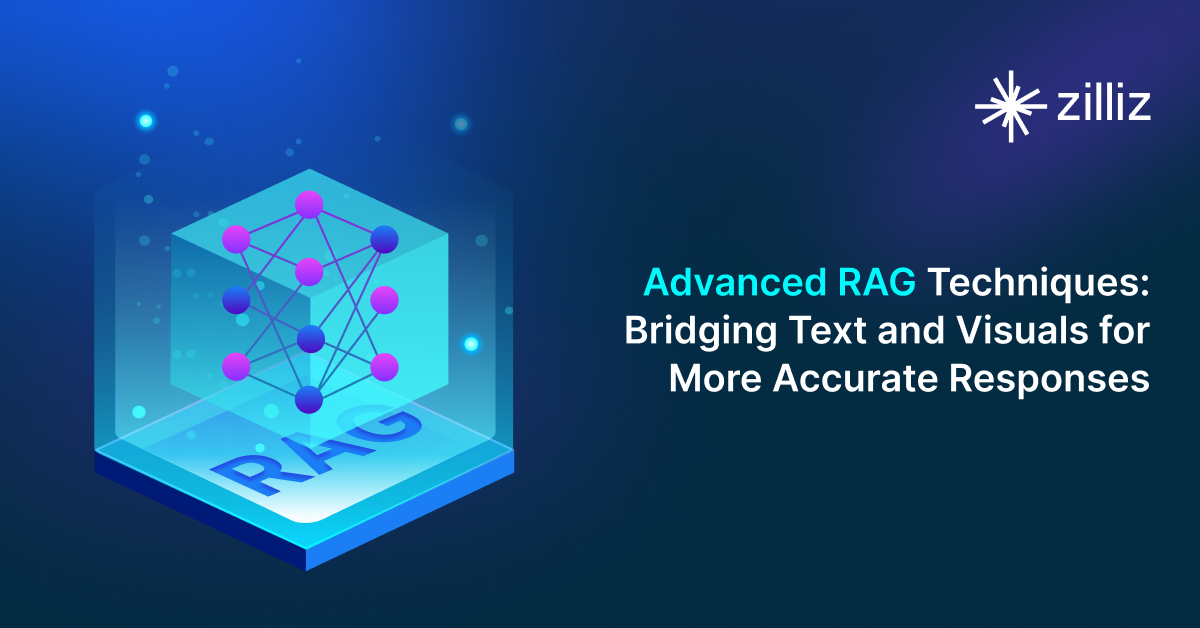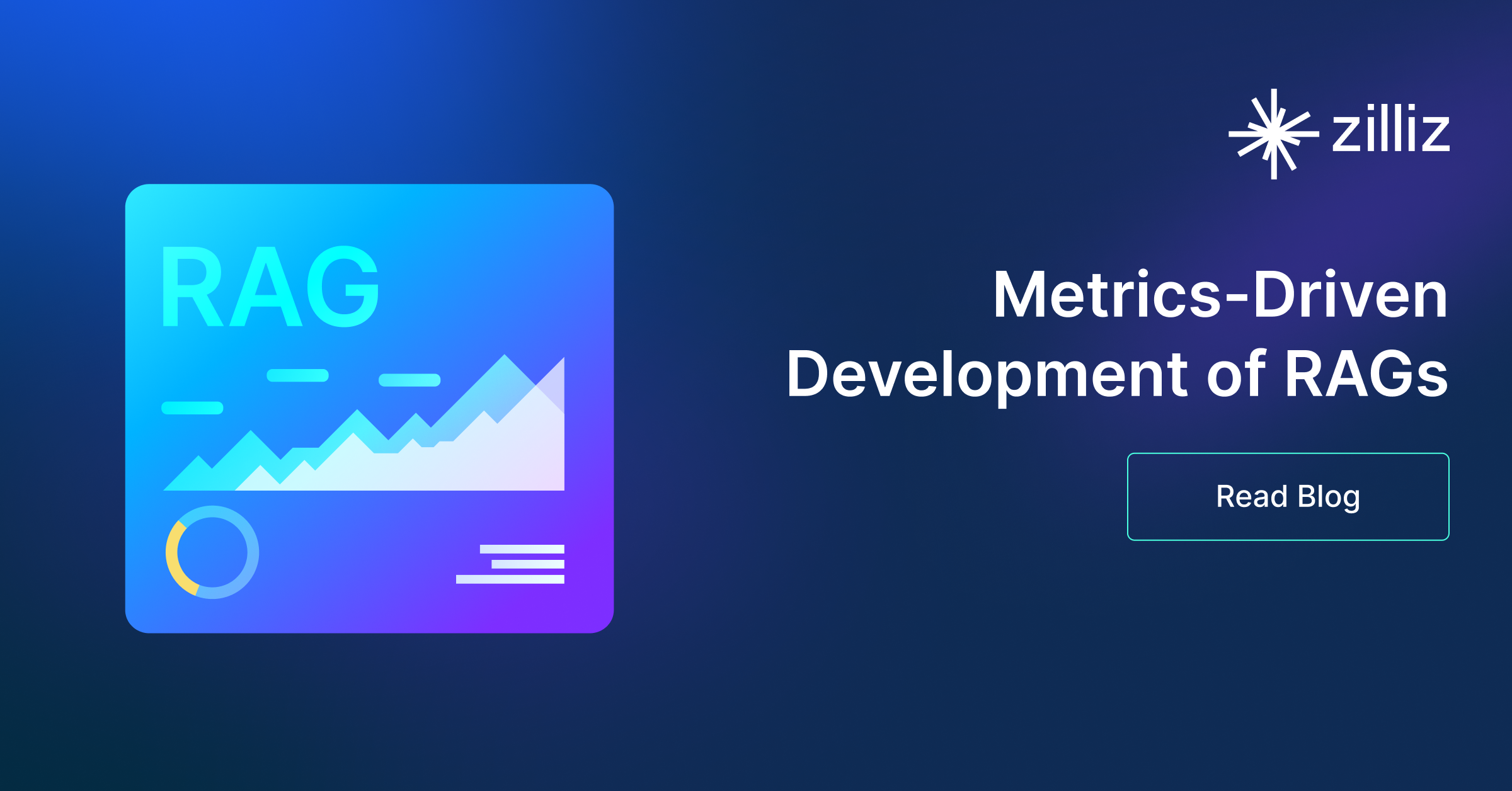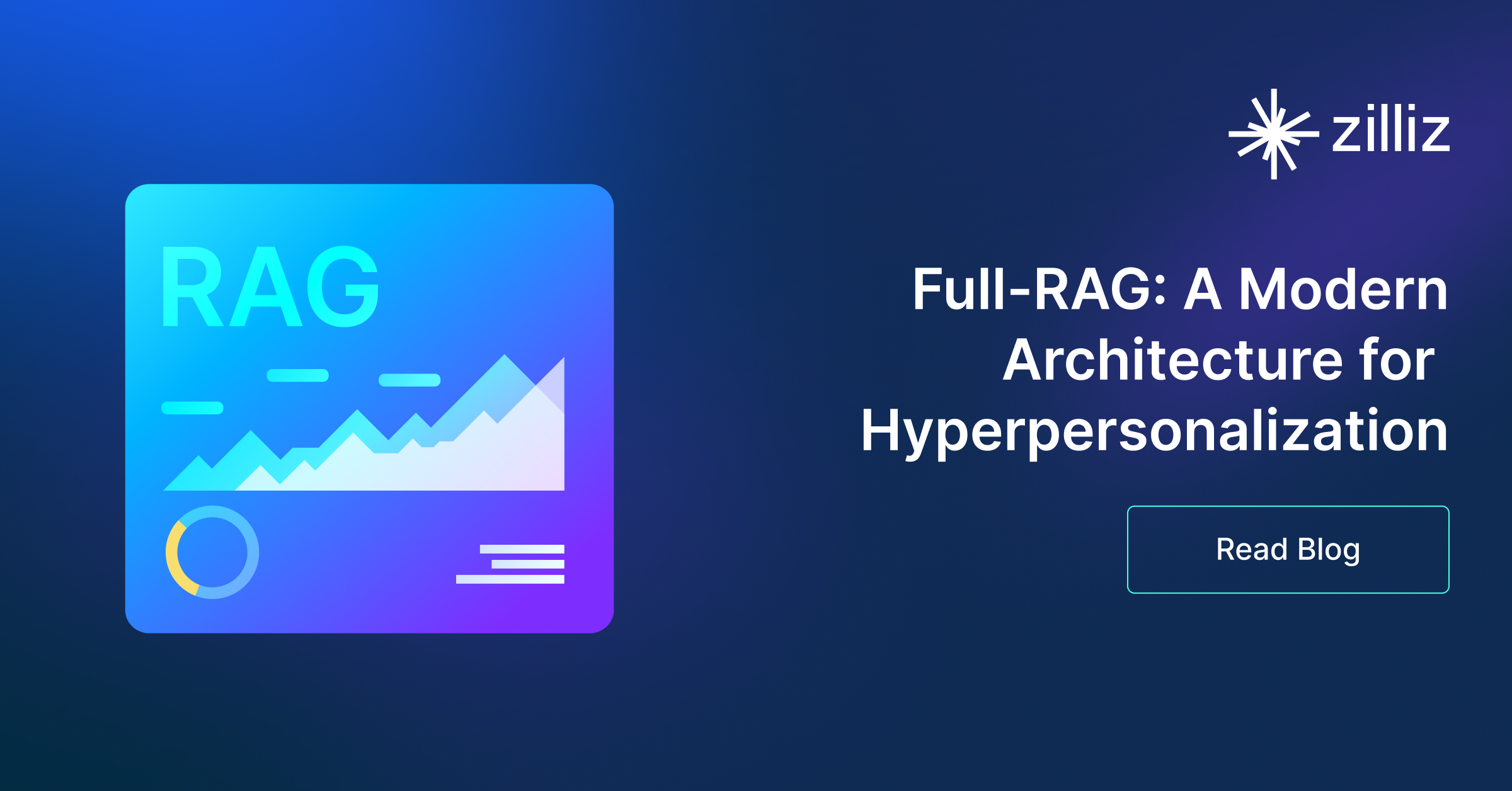Build RAG Chatbot with LangChain, Milvus, Anthropic Claude 3 Opus, and Ollama snowflake-arctic-embed
Introduction to RAG
Retrieval-Augmented Generation (RAG) is a game-changer for GenAI applications, especially in conversational AI. It combines the power of pre-trained large language models (LLMs) like OpenAI’s GPT with external knowledge sources stored in vector databases such as Milvus and Zilliz Cloud, allowing for more accurate, contextually relevant, and up-to-date response generation. A RAG pipeline usually consists of four basic components: a vector database, an embedding model, an LLM, and a framework.
Key Components We'll Use for This RAG Chatbot
This tutorial shows you how to build a simple RAG chatbot in Python using the following components:
- LangChain: An open-source framework that helps you orchestrate the interaction between LLMs, vector stores, embedding models, etc, making it easier to integrate a RAG pipeline.
- Milvus: An open-source vector database optimized to store, index, and search large-scale vector embeddings efficiently, perfect for use cases like RAG, semantic search, and recommender systems. If you hate to manage your own infrastructure, we recommend using Zilliz Cloud, which is a fully managed vector database service built on Milvus and offers a free tier supporting up to 1 million vectors.
- Anthropic Claude 3 Opus: This advanced model in the Claude 3 series is designed for complex reasoning and nuanced conversations. It combines deep understanding with ethical considerations, making it ideal for sensitive applications like customer support, therapy chatbots, and content generation where context and empathy are paramount.
- Ollama Snowflake-Arctic-Embed: This model specializes in generating high-dimensional embeddings for structured and unstructured data, leveraging advanced deep learning techniques. Its strengths include efficient handling of large datasets and producing contextual representations, making it ideal for applications in recommendation systems, semantic search, and personalized content delivery.
By the end of this tutorial, you’ll have a functional chatbot capable of answering questions based on a custom knowledge base.
Note: Since we may use proprietary models in our tutorials, make sure you have the required API key beforehand.
Step 1: Install and Set Up LangChain
%pip install --quiet --upgrade langchain-text-splitters langchain-community langgraph
Step 2: Install and Set Up Anthropic Claude 3 Opus
pip install -qU "langchain[anthropic]"
import getpass
import os
if not os.environ.get("ANTHROPIC_API_KEY"):
os.environ["ANTHROPIC_API_KEY"] = getpass.getpass("Enter API key for Anthropic: ")
from langchain.chat_models import init_chat_model
llm = init_chat_model("claude-3-opus-latest", model_provider="anthropic")
Step 3: Install and Set Up Ollama snowflake-arctic-embed
pip install -qU langchain-ollama
from langchain_ollama import OllamaEmbeddings
embeddings = OllamaEmbeddings(model="snowflake-arctic-embed")
Step 4: Install and Set Up Milvus
pip install -qU langchain-milvus
from langchain_milvus import Milvus
vector_store = Milvus(embedding_function=embeddings)
Step 5: Build a RAG Chatbot
Now that you’ve set up all components, let’s start to build a simple chatbot. We’ll use the Milvus introduction doc as a private knowledge base. You can replace it with your own dataset to customize your RAG chatbot.
import bs4
from langchain import hub
from langchain_community.document_loaders import WebBaseLoader
from langchain_core.documents import Document
from langchain_text_splitters import RecursiveCharacterTextSplitter
from langgraph.graph import START, StateGraph
from typing_extensions import List, TypedDict
# Load and chunk contents of the blog
loader = WebBaseLoader(
web_paths=("https://milvus.io/docs/overview.md",),
bs_kwargs=dict(
parse_only=bs4.SoupStrainer(
class_=("doc-style doc-post-content")
)
),
)
docs = loader.load()
text_splitter = RecursiveCharacterTextSplitter(chunk_size=1000, chunk_overlap=200)
all_splits = text_splitter.split_documents(docs)
# Index chunks
_ = vector_store.add_documents(documents=all_splits)
# Define prompt for question-answering
prompt = hub.pull("rlm/rag-prompt")
# Define state for application
class State(TypedDict):
question: str
context: List[Document]
answer: str
# Define application steps
def retrieve(state: State):
retrieved_docs = vector_store.similarity_search(state["question"])
return {"context": retrieved_docs}
def generate(state: State):
docs_content = "\n\n".join(doc.page_content for doc in state["context"])
messages = prompt.invoke({"question": state["question"], "context": docs_content})
response = llm.invoke(messages)
return {"answer": response.content}
# Compile application and test
graph_builder = StateGraph(State).add_sequence([retrieve, generate])
graph_builder.add_edge(START, "retrieve")
graph = graph_builder.compile()
Test the Chatbot
Yeah! You've built your own chatbot. Let's ask the chatbot a question.
response = graph.invoke({"question": "What data types does Milvus support?"})
print(response["answer"])
Example Output
Milvus supports various data types including sparse vectors, binary vectors, JSON, and arrays. Additionally, it handles common numerical and character types, making it versatile for different data modeling needs. This allows users to manage unstructured or multi-modal data efficiently.
Optimization Tips
As you build your RAG system, optimization is key to ensuring peak performance and efficiency. While setting up the components is an essential first step, fine-tuning each one will help you create a solution that works even better and scales seamlessly. In this section, we’ll share some practical tips for optimizing all these components, giving you the edge to build smarter, faster, and more responsive RAG applications.
LangChain optimization tips
To optimize LangChain, focus on minimizing redundant operations in your workflow by structuring your chains and agents efficiently. Use caching to avoid repeated computations, speeding up your system, and experiment with modular design to ensure that components like models or databases can be easily swapped out. This will provide both flexibility and efficiency, allowing you to quickly scale your system without unnecessary delays or complications.
Milvus optimization tips
Milvus serves as a highly efficient vector database, critical for retrieval tasks in a RAG system. To optimize its performance, ensure that indexes are properly built to balance speed and accuracy; consider utilizing HNSW (Hierarchical Navigable Small World) for efficient nearest neighbor search where response time is crucial. Partitioning data based on usage patterns can enhance query performance and reduce load times, enabling better scalability. Regularly monitor and adjust cache settings based on query frequency to avoid latency during data retrieval. Employ batch processing for vector insertions, which can minimize database lock contention and enhance overall throughput. Additionally, fine-tune the model parameters by experimenting with the dimensionality of the vectors; higher dimensions can improve retrieval accuracy but may increase search time, necessitating a balance tailored to your specific use case and hardware infrastructure.
Anthropic Claude 3 Opus optimization tips
Claude 3 Opus is a powerful model for RAG applications requiring deep reasoning and high-quality responses. Optimize performance by structuring retrieval results effectively, ensuring that only the most relevant context is provided to avoid unnecessary token usage. Utilize a ranker to prioritize key passages before sending them to the model, preventing information overload and improving response quality. Fine-tune hyperparameters like temperature (0.1–0.3 for factual tasks) and top-k sampling to maintain accuracy while controlling response variation. If cost and speed are concerns, use Claude 3 Opus selectively for complex queries while relying on a smaller model like Claude 3 Haiku for simpler tasks. Implement caching for repeated or high-frequency queries to minimize API calls and improve latency. Use Claude’s parallel processing capabilities where applicable to handle multiple document queries efficiently.
Ollama snowflake-arctic-embed optimization tips
To optimize the Ollama snowflake-arctic-embed component in your Retrieval-Augmented Generation setup, ensure that you fine-tune the embedding model on domain-specific data to improve relevance and accuracy. Utilize a caching mechanism for frequently accessed embeddings to reduce computation time. Experiment with different embedding dimensions to balance performance and resource usage, and implement vector quantization techniques to save memory space without significantly impacting quality. Additionally, regularly monitor the performance metrics and adjust your hyperparameters accordingly to achieve the best outcomes in your retrieval tasks.
By implementing these tips across your components, you'll be able to enhance the performance and functionality of your RAG system, ensuring it’s optimized for both speed and accuracy. Keep testing, iterating, and refining your setup to stay ahead in the ever-evolving world of AI development.
RAG Cost Calculator: A Free Tool to Calculate Your Cost in Seconds
Estimating the cost of a Retrieval-Augmented Generation (RAG) pipeline involves analyzing expenses across vector storage, compute resources, and API usage. Key cost drivers include vector database queries, embedding generation, and LLM inference.
RAG Cost Calculator is a free tool that quickly estimates the cost of building a RAG pipeline, including chunking, embedding, vector storage/search, and LLM generation. It also helps you identify cost-saving opportunities and achieve up to 10x cost reduction on vector databases with the serverless option.
 Calculate your RAG cost
Calculate your RAG cost
What Have You Learned?
By diving into this tutorial, you’ve unlocked the magic of building a RAG (Retrieval-Augmented Generation) system from the ground up! You learned how LangChain acts as the glue, seamlessly orchestrating the flow between components. With its intuitive framework, you connected Milvus, a powerhouse vector database, to store and retrieve embeddings at lightning speed. You saw how Anthropic Claude 3 Opus—a cutting-edge LLM—brings human-like reasoning to generate insightful, context-aware responses, while Ollama’s snowflake-arctic-embed model transformed raw text into rich, meaningful vectors. Together, these tools form a dynamic pipeline: your data gets embedded, stored efficiently in Milvus, and retrieved to supercharge Claude’s knowledge with real-time context. You even explored pro tips for optimizing performance, like tuning chunk sizes and tweaking similarity thresholds, ensuring your RAG system stays fast and accurate. Plus, the free RAG cost calculator gave you a practical way to estimate expenses and scale wisely—no surprises!
Now that you’ve seen how these pieces fit together, the world of AI-powered applications is yours to shape. Imagine building chatbots that answer like experts, research assistants that synthesize mountains of data, or creative tools that blend knowledge with imagination. You’ve got the blueprint. Tinker with different models, experiment with hybrid search strategies, or layer in domain-specific data to make your RAG system truly unique. The skills you’ve gained here aren’t just about code—they’re about creating solutions that think. So fire up your IDE, embrace the trial-and-error joy of innovation, and start building something that blows minds. The future of intelligent apps starts with you. Let’s go! 🚀
Further Resources
🌟 In addition to this RAG tutorial, unleash your full potential with these incredible resources to level up your RAG skills.
- How to Build a Multimodal RAG | Documentation
- How to Enhance the Performance of Your RAG Pipeline
- Graph RAG with Milvus | Documentation
- How to Evaluate RAG Applications - Zilliz Learn
- Generative AI Resource Hub | Zilliz
We'd Love to Hear What You Think!
We’d love to hear your thoughts! 🌟 Leave your questions or comments below or join our vibrant Milvus Discord community to share your experiences, ask questions, or connect with thousands of AI enthusiasts. Your journey matters to us!
If you like this tutorial, show your support by giving our Milvus GitHub repo a star ⭐—it means the world to us and inspires us to keep creating! 💖
- Introduction to RAG
- Key Components We'll Use for This RAG Chatbot
- Step 1: Install and Set Up LangChain
- Step 2: Install and Set Up Anthropic Claude 3 Opus
- Step 3: Install and Set Up Ollama snowflake-arctic-embed
- Step 4: Install and Set Up Milvus
- Step 5: Build a RAG Chatbot
- Optimization Tips
- RAG Cost Calculator: A Free Tool to Calculate Your Cost in Seconds
- What Have You Learned?
- Further Resources
- We'd Love to Hear What You Think!
Content
Vector Database at Scale
Zilliz Cloud is a fully-managed vector database built for scale, perfect for your RAG apps.
Try Zilliz Cloud for Free


